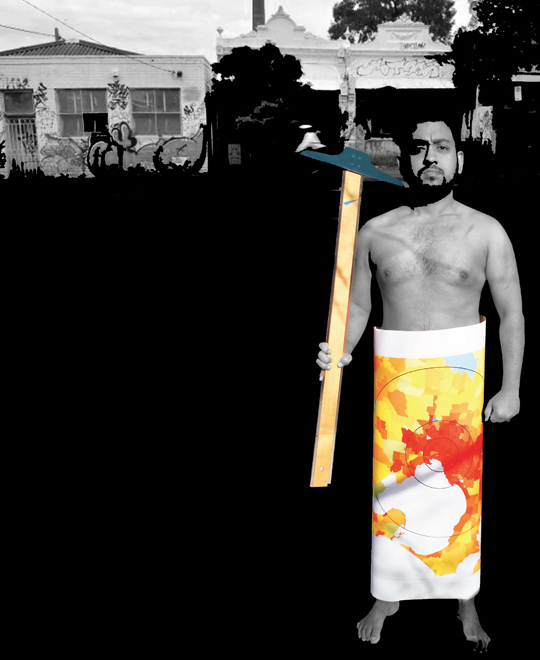Studio 24
Naked and Afraid: Architects in Melbourne’s Sprawlscape
Tanzil Shafique

Studio Description
Why do people still want the American Dream—the white picket fence, the trimmed lawn, two cars in the garage, the single-family house? Could there be a new Australian dream in its stead? This studio will look at the “sprawlscape”—the vast wilderness of suburban settings around Melbourne as a site to re-imagine the housing narratives. Rather than treating housing as real-estate products, the studio will redefine housing as a process of habitation. The design outcome of the studio will follow from the analysis of the potentialities inherent of the sprawlscape. For that, the studio will do comparative analysis of precedents of alternative housing typologies and historical analysis of pre-carbon cities in relation to Melbourne’s suburbs. In addition, the studio will operate in the context of the next global financial crisis, attempting to pre-empt the architectural response to such crisis. The studio will explore the role of architectural and urban interventions in reimagining the sprawlscape by introducing new narratives of housing and living.
Studio Outcomes
- Gain an understanding of the social and political role of design, architecture and urbanism. In particular understand housing design as a process.
- Value social resilience and develop a holistic notion of sustainability.
- Practice collaborative problem-solving through design moving beyond disciplinary silos.
- Question the prevalent practices of architecture and urbanism that are unaware of social consequences.
- Experiment with forms of drawing social interactions in built environment.
- A publication with the studio materials.
Studio Format
- Week 1-3: Designing the question (site investigation, precedent analysis)
- Week 4-5: Design Charrette (Speculation)
- Week 6: Mid-semester Reviews (Reflection and inputs)
- Week 7-10: Design Development (Synthesis)
- Week 11-12: Design Representation (Narrative)
Studio Design Scope
The studio outcome can range from retrofitting existing housing, new housing typologies, redesigning suburban strip malls, to imagining a post-suburban utopia.
Studio Leader
Tanzil Shafique, Assoc. AIA, is a Ph.D researcher at the Melbourne School of Design, where he also leads graduate design studios. He co-founded and now co-directs Estudio Abierto/Open Studio, a think+do tank on architecture and urbanism. Previously he was a Research Fellow and Studio Instructor at the Fay Jones School of Architecture + Design as well as Project Designer at the Community Design Center, both at the University of Arkansas. His work has garnered numerous AIA National Award for Urban Design as well as his writing on design philosophy and urbanism has been published internationally. He holds an M.Arch in Ecological Urbanism from Rensselaer Polytechnic Institute in New York.
Reading & Reference
- James Howard Kunstler (1994), The Geography of Nowhere: The Rise and Decline of America's Man-Made Landscape
- Barry Bergdoll and Reinhold Martin (2012), Foreclosed: Rehousing the American Dream
- Robert A.M. Stern and David Fishman (2013), Paradise Planned: The Garden Suburb and the Modern City
- PennDesign (2011), The Penn Resolution: Educating Urban Designers for Post-Carbon Cities
- Nicholas A. Phelps (2015), Sequel to Suburbia: Glimpses of America's Post-Suburban Future
- Katy Chey (2017), Multi-Unit Housing in Urban Cities: From 1800 to Present Day
- Dominique Boudet (2018), New Housing in Zurich: Typologies for a Changing Society
- Paul Karakusevic and Abigail Batchelor (2017), Social Housing: Definitions and Design Exemplars
- Graham Cairns and Rachel Isaac-Menard (2017), Housing the Future: Alternative Approaches for Tomorrow
- Aurora Fernandez Per and Javier Mozas (2013), 10 Stories of Collective Housing by A+t Research Group
ST1/24 Mondays 09:00-12:00 in MSD Room 244
ST2/24 Thursdays 09:00-12:00 in MSD Room 142